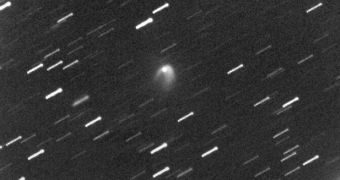Astronomers announce that 596Scheila, a space object that has been known for some time, and which was until now believed to be an asteroid, has just revealed that it actually has a tail and come. This, by all definitions, makes is a fully-fledged comet.
Experts say that cases in which space rocks turn out to be in fact comets are not at all uncommon. This has happened before, and will most likely happen again as telescopes get more advanced.
The announcement about Scheila was made yesterday, December 12, by expert astronomer Steve Larson. The scientist is based at the University of Arizona Lunar and Planetary Laboratory (LPL).
He was the first person to report images of the minor planet on December 11, showing that the object was at the time undergoing an outburst of sorts, which would have been very unusual for an asteroid.
With an increase in brightness from magnitude 14.5 to 13.4, its comet-like appearance became clear, and subsequent observations conducted by other investigators and observatories around the world confirmed the discovery only hours later.
October 18, November 2 and November 11 images of Scheila show an object with a star-like appearance, which is totally characteristic for asteroids, as seen from our planet. A December 3 image shows the body exhibiting some diffuseness around its margins.
This means that the event discovered by Larson began, or had already begun, by that time. Some astronomers proposed immediately after the discovery that an impact event had taken place.
It could have possible for a meteorite, another asteroid, or even a comet, to slam into the surface of the space rock, and to trigger the emissions of clouds of dust particles. These would have given the body the diffuse glow the researchers say.
The asteroid was discovered by A. Kopff back on February 21, 1906, and named after a friend. The name is unlikely to stick though, as the International Astronomical Union (IAU) has its own system for named space bodies.
Scheila is most likely an object from the Main Belt Comets (MBC) class, which means that it has a course inside Jupiter’s orbit like main belt asteroids, but is in fact a comet, Universe Today reports.

 14 DAY TRIAL //
14 DAY TRIAL //